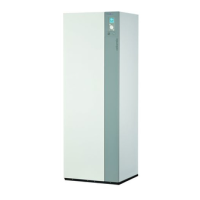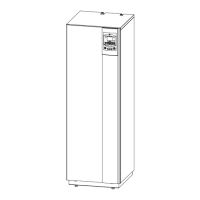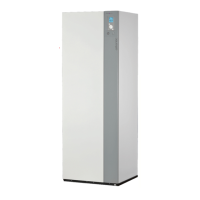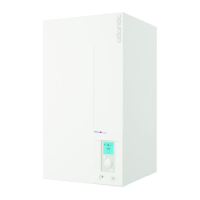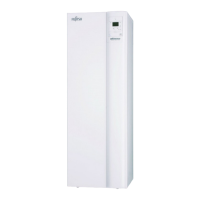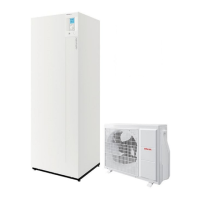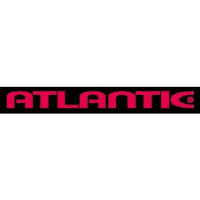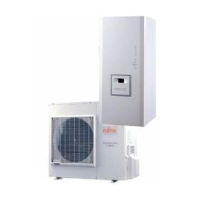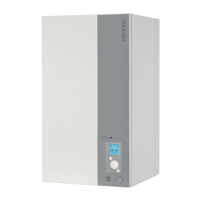
Do you have a question about the Atlantic Alfea Excellia HP A.I. Series and is the answer not in the manual?
Warning regarding the hydraulic unit's installation in air currents.
Guidelines for transporting and handling the outdoor unit to prevent damage.
Importance of protecting refrigeration circuits from contamination and moisture for reliability.
Recommendations for sealing hydraulic connections using appropriate materials and practices.
Guidance on using glycol/water mix for low temperatures and its concentration.
Addressing corrosion issues from mixed metals and recommending inhibitors.
Safety instruction to switch off power supply before performing any maintenance operation.
Requirements for electricity supply, including voltage, frequency, and breaker types.
Guidelines on polarity, wire types, cable glands, and terminal connections.
Instructions for connecting wires to screw terminals, controller boards, and spring terminals.
Information on packaging contents and procedures for unpacking appliances.
Explanations of key terms like Split, Air/water, Inverter, and COP.
List of optional accessories that can be added to the heat pump system.
Details on the heat pump's capabilities for heating, cooling, and domestic hot water production.
Guidelines for bending, shaping, and protecting refrigeration pipes during installation.
Overview of the controller's menu hierarchy and available sections.
List of error codes, probable causes, and proposed actions for hydraulic unit faults.
Table detailing error codes, LED status, and error designations for outdoor unit faults.
Procedures for checking hydraulic pressure, refrigeration circuit leaks, and components.
Steps for inspecting the outdoor unit and verifying electrical connections.
Steps for draining the hydraulic unit by removing the panel and opening valves.
Guidance on the correct fitting and operation of the distribution valve for hot water tanks.
A checklist for verifying all components and connections before starting the unit.
Steps for initial appliance setup, including preheating, initialization, and configuration.
Information on packaging contents and procedures for unpacking appliances.
Explanations of key terms like Split, Air/water, Inverter, and COP.
List of optional accessories that can be added to the heat pump system.
Details on the heat pump's capabilities for heating, cooling, and domestic hot water production.
Identification and description of the various components of the outdoor unit.
Explanation of the heat pump's control functions like temperature control and backup heating.
Description of protective features like anti-legionella cycle and frost protection.
Guidelines for bending, shaping, and protecting refrigeration pipes during installation.
Precautions for installing the outdoor unit, including location and clearances.
Precautions for installing the hydraulic unit, including space requirements and room volume.
Steps for securely fixing the mounting bracket and hanging the hydraulic unit.
Precautions for handling refrigerants and essential tools required for connections.
Techniques for bending and creating flarings on refrigeration pipes without damage.
Detailed steps for cutting and creating flarings on pipes for connections.
Procedure for checking and connecting the gas line with nitrogen.
Procedure for checking and connecting the liquid line with nitrogen.
Table specifying tightening torques for various nuts and plugs.
Appendix 1 detailing how to calibrate and check the vacuum pump's performance.
Appendix 2 outlining the triple evacuation method for installations below 10°C.
Information on calculating and performing additional refrigerant filling based on pipe length.
Final checks for leaks after gas filling using a certified detector.
Steps for connecting the hydraulic unit to the heating system, including flushing.
Procedures for rinsing the heating system to remove impurities before connecting the unit.
Details on connecting heating pipes, pump, union connectors, and drains.
Diagram showing the general wiring for a single heating circuit installation.
Guidelines for correctly matching terminal blocks for interconnection cables.
Instructions for connecting power supply for electrical backups and boiler.
Information on DHW tank backup and configuring for energy supplier tariffs.
Setting up power limitation and connecting external fault components.
Steps for connecting wired room sensors A59 and A75.
Procedure for connecting the Typass ATL accessory.
Note that room sensors should not be used with fan convectors.
How the 'Easy Start' function helps set initial appliance parameters like language, date, and power.
Overview of the controller's display and buttons for 1 or 2 heating circuit versions.
Guidance on configuring temperature control based on dwelling insulation and radiator type.
Overview of the controller's menu hierarchy and available sections.
Method for adjusting temperature control using flow temperature setpoints.
Method for adjusting temperature control using gradient and off-set.
Setting the system to use 100% ambient temperature and adjusting radiator type.
Settings related to compressor operation, shutdown time, and power shedding.
Configuration for summer/winter switchover, cooling switchover, and circuit 2 settings.
Settings for domestic hot water, including max temperature and switching differential.
Overview of currently operating functions and how to change their status.
Accessing the control panel to view the status of functions and actuators.
Viewing the log of past errors and their designations.
Instructions for using the floor drying function, including drying types and flow temperature setpoints.
How to set the appliance's date and time through the settings menu.
How to change the appliance's display language through the settings menu.
Hydraulic diagram for a system with one heating circuit, including components and connections.
Detailed wiring diagram for the single-phase outdoor unit.
List of error codes, probable causes, and proposed actions for hydraulic unit faults.
Checking hydraulic system pressure, leaks, and components.
Inspecting and cleaning the outdoor unit's exchanger, fan, and drain.
Annual checks of the refrigeration circuit by a certified engineer.
Checking and tightening electrical connections and cables.
Steps for draining the hydraulic unit by removing the panel and opening valves.
Guidance on the correct fitting and operation of the distribution valve for hot water tanks.
A checklist for verifying all components and connections before starting the unit.
